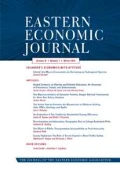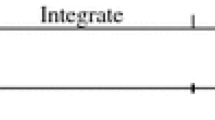Abstract
This study analyzes both the determinants of small firm exit rates in US manufacturing over the 1989–2004 period, especially the reaction of domestic firms to the nature of foreign competition as measured by industry-specific real exchange rate movements (interacted with import penetration by industry). These international pressures seem to lead to increased rates of smallest-firm exit in manufacturing, though the magnitudes of these effects are smaller than sometimes discussed. However, high-tech industries avoid much of this impact; patents and a reputation for innovation may shield a small firm somewhat from lower-priced foreign competitors.
Similar content being viewed by others
Notes
This is the conventional cutoff for research purposes, though the US Small Business Administration uses revenue limits in defining small businesses outside of manufacturing and mining, especially for applicability for government preferential programs.
Recent work by Balasubramanian and Sivadasan [2011] combines detailed NBER patent data and Census microdata to find significant firm size and productivity gains in patenting firms.
There does seem to be a post-9/11 spike — in 2002 — in exit rates for the very smallest and largest of these size categories.
As the dependent variable, exit rate, is a “limited dependent variable” which by definition cannot fall below zero, an alternative estimation approach — a Tobit estimation with random industry effects — using the xttobit routine in STATA — was also attempted, with results quite similar to what is reported below in Tables 6 and 7. Allowing for within-industry autocorrelation was also tested, with results again similar to those reported here. Hausman tests support random vs fixed effects in six of the eight regression specifications at the 5 percent level of significance, in all eight at 1 percent.
References
Audretsch, David B. 1994. Business Survival and the Decision to Exit. International Journal of the Economics of Business, 1 (1): 125–137.
Audretsch, David B., and Talat Mahmood . 1995. New Firm Survival: New Results Using a Hazard Function. Review of Economics and Statistics, 77 (1): 97–103.
Balasubramanian, Natarajan, and Jagadeesh Sivadasan . 2011. What Happens When Firms Patent? New Evidence from U.S. Economic Census Data. Review of Economics and Statistics, 93 (1): 126–146.
Bernard, Andrew B., and J. Bradford Jensen . 2007. Firm Structure, Multinationals, and Manufacturing Plant Deaths. Review of Economics and Statistics, 89 (2): 193–204.
De Backer, Koen, and Leo Sleuwaegen . 2003. Does Foreign Direct Investment Crowd Out Domestic Entrepreneurship? Review of Industrial Organization, 22 (1): 67–84.
Dunne, Timothy, Mark Roberts, and Larry Samuelson . 1988. Patterns of Firm Entry and Exit in U.S. Manufacturing Industries. RAND Journal of Economics, 19 (4): 495–515.
Feinberg, Robert M 2010. Do International Shocks Affect Small Wholesalers and Retailers? Review of World Economics, 146 (2): 323–338.
Flynn, Joseph E 1991. The Determinants of Exit in an Open Economy. Small Business Economics, 3 (3): 225–232.
Ghemawat, Pankaj, and Barry Nalebuff . 1985. Exit. RAND Journal of Economics, 16 (2): 184–194.
Headd, Brian 2003. Redefining Business Success: Distinguishing Between Closure and Failure. Small Business Economics, 21 (1): 51–61.
Jovanovic, Boyan 1982. Selection and the Evolution of Industry. Econometrica, 50 (3): 649–670.
Kleijweg, Aad J.M., and Marcel H.C. Lever . 1996. Entry and Exit in Dutch Manufacturing Industries. Review of Industrial Organization, 11 (3): 375–382.
Phillips, Bruce D., and Bruce A. Kirchhoff . 1989. Formation, Growth and Survival: Small Firm Dynamics in the US Economy. Small Business Economics, 1 (1): 65–74.
Shapiro, Daniel, and R.S. Khemani . 1987. The Determinants of Entry and Exit Reconsidered. International Journal of Industrial Organization, 5 (1): 15–26.
Wagner, Joachim 1994. The Post-Entry Performance of New Small Firms in German Manufacturing Industries. Journal of Industrial Economics, 42 (2): 141–154.
Acknowledgements
The author is grateful for financial support from the US Small Business Administration under Contract # SBAHQ07M0404, and to Brian Headd and two anonymous referees for helpful comments and suggestions on earlier drafts. Views expressed are those of the author alone, and are not those of the US Small Business Administration.
Author information
Authors and Affiliations
Rights and permissions
About this article
Cite this article
Feinberg, R. International Competition and Small-Firm Exit in US Manufacturing. Eastern Econ J 39, 402–414 (2013). https://doi.org/10.1057/eej.2012.19
Published:
Issue Date:
DOI: https://doi.org/10.1057/eej.2012.19



